Complex Nonlinearity: Chaos, Phase Transitions, Topology Change and Path Integrals is a book about prediction & control of general nonlinear and chaotic dynamics of high-dimensional complex systems of various physical and non-physical nature and their underpinning geometro-topological change.
The book starts with a textbook-like expose on nonlinear dynamics, attractors and chaos, both temporal and spatio-temporal, including modern techniques of chaos-control. Chapter 2 turns to the edge of chaos, in the form of phase transitions (equilibrium and non-equilibrium, oscillatory, fractal and noise-induced), as well as the related field of synergetics. While the natural stage for linear dynamics comprises of flat, Euclidean geometry (with the corresponding calculation tools from linear algebra and analysis), the natural stage for nonlinear dynamics is curved, Riemannian geometry (with the corresponding tools from nonlinear, tensor algebra and analysis). The extreme nonlinearity - chaos - corresponds to the topology change of this curved geometrical stage, usually called configuration manifold. Chapter 3 elaborates on geometry and topology change in relation with complex nonlinearity and chaos. Chapter 4 develops general nonlinear dynamics, continuous and discrete, deterministic and stochastic, in the unique form of path integrals and their action-amplitude formalism. This most natural framework for representing both phase transitions and topology change starts with Feynman's sum over histories, to be quickly generalized into the sum over geometries and topologies. The last Chapter puts all the previously developed techniques together and presents the unified form of complex nonlinearity. Here we have chaos, phase transitions, geometrical dynamics and topology change, all working together in the form of path integrals.
The objective of this book is to provide a serious reader with a serious scientific tool that willenable themto actually perform a competitive research in modern complex nonlinearity. It includes a comprehensive bibliography on the subject and a detailed index. Target readership includes all researchers and students of complex nonlinear systems (in physics, mathematics, engineering, chemistry, biology, psychology, sociology, economics, medicine, etc.), working both in industry/clinics and academia.
The book starts with a textbook-like expose on nonlinear dynamics, attractors and chaos, both temporal and spatio-temporal, including modern techniques of chaos-control. Chapter 2 turns to the edge of chaos, in the form of phase transitions (equilibrium and non-equilibrium, oscillatory, fractal and noise-induced), as well as the related field of synergetics. While the natural stage for linear dynamics comprises of flat, Euclidean geometry (with the corresponding calculation tools from linear algebra and analysis), the natural stage for nonlinear dynamics is curved, Riemannian geometry (with the corresponding tools from nonlinear, tensor algebra and analysis). The extreme nonlinearity - chaos - corresponds to the topology change of this curved geometrical stage, usually called configuration manifold. Chapter 3 elaborates on geometry and topology change in relation with complex nonlinearity and chaos. Chapter 4 develops general nonlinear dynamics, continuous and discrete, deterministic and stochastic, in the unique form of path integrals and their action-amplitude formalism. This most natural framework for representing both phase transitions and topology change starts with Feynman's sum over histories, to be quickly generalized into the sum over geometries and topologies. The last Chapter puts all the previously developed techniques together and presents the unified form of complex nonlinearity. Here we have chaos, phase transitions, geometrical dynamics and topology change, all working together in the form of path integrals.
The objective of this book is to provide a serious reader with a serious scientific tool that willenable themto actually perform a competitive research in modern complex nonlinearity. It includes a comprehensive bibliography on the subject and a detailed index. Target readership includes all researchers and students of complex nonlinear systems (in physics, mathematics, engineering, chemistry, biology, psychology, sociology, economics, medicine, etc.), working both in industry/clinics and academia.
From the reviews:
"Intended as a graduate-level monographic textbook this volume is devoted to a topological-differential geometric approach to the four notions added in title: chaos, phase transitions, topology change, path integrals. ... This ... can be useful for a beginner. The book has a very large list of references on almost 120 pages which is an excellent overview of the developments in these main areas of research and also a detailed and useful index." (Mirea Crâusmareanu, Zentralblatt MATH, Vol. 1152, 2009)
"This monograph is intended for researchers and graduate students concerned with prediction and control of general complex nonlinear dynamical systems. The book begins with introductory material on nonlinear and chaotic dynamics and ends with a presentation of the 'unified form of complex nonlinearity.'" (IEEE Control Systems Magazine, Vol. 29, October, 2009)
"Intended as a graduate-level monographic textbook this volume is devoted to a topological-differential geometric approach to the four notions added in title: chaos, phase transitions, topology change, path integrals. ... This ... can be useful for a beginner. The book has a very large list of references on almost 120 pages which is an excellent overview of the developments in these main areas of research and also a detailed and useful index." (Mirea Crâusmareanu, Zentralblatt MATH, Vol. 1152, 2009)
"This monograph is intended for researchers and graduate students concerned with prediction and control of general complex nonlinear dynamical systems. The book begins with introductory material on nonlinear and chaotic dynamics and ends with a presentation of the 'unified form of complex nonlinearity.'" (IEEE Control Systems Magazine, Vol. 29, October, 2009)








